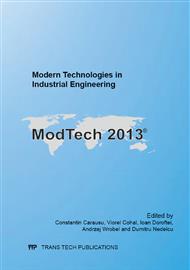[1]
S.P. Patil, S.P. Parit, Y.N. Burali, Review Paper On Poka Yoke: The Revolutionary Idea In Total Productive Management, International Journal Of Engineering And Science, vol. 2, Issue 4 (2013) 19-24.
Google Scholar
[2]
B.S. Dhillon, Engineering Maintenance - A Modern Approach, CRC Press, New York, (2002).
Google Scholar
[3]
R. K. Mobley, Root cause failure analysis, Butterworth-Heinemann, Oxford, (1999).
Google Scholar
[4]
A. Gwiazda, Quality Tools in a Process of Technical Project Management, Journal of Achievements in Materials and Manufacturing Engineering Vol. 18 Issue 1-2 (2006) 439 – 442.
Google Scholar
[5]
A. Gwiazda, Multi-criterion Analysis Technique in a Process of Quality Management, Journal of Achievements in Materials and Manufacturing Engineering Vol. 25, Issue 1 (2007) 75-78.
Google Scholar
[6]
A. Gwiazda, Technical Project Management Using Quality Methods, Journal of Achievements in Materials and Manufacturing Engineering Vol. 31, Issue 2 (2008) 739 – 746.
Google Scholar
[7]
C. Grabowik, W. Janik, The concrete casting matrixes inserts design preparation based on the master models, Advanced Materials Research, Advanced Material Science and Mechanics vol. 702 (2013) 259-262.
DOI: 10.4028/www.scientific.net/amr.702.259
Google Scholar
[8]
P. Gendarz, W. Janik, Refurbishing technologies of hydraulic actuators applied in mining industry, Journal of Achievements in Materials and Manufacturing Engineering 41/1-2 (2010) 104-111.
Google Scholar
[9]
M.P. Hetmanczyk, P. Michalski, J. Świder, Utilization of advanced self-diagnostic functions implemented in frequency inverters for the purpose of the computer-aided identification of operating conditions, Journal of Vibroengineering 14 (2012).
Google Scholar
[10]
D. Krenczyk, K. Kalinowski, C. Grabowik, Integration Production Planning and Scheduling Systems for Determination of Transitional Phases in Repetitive Production, in: E. Corchado, V. Snasel, A. Abraham et al. (eds. ), Hybrid Artificial Intelligent Systems II Book Series: Lecture Notes in Computer Science vol. 7209, Springer-Verlag, Heidelberg, 2012, pp.274-283.
DOI: 10.1007/978-3-642-28931-6_27
Google Scholar
[11]
D. Krenczyk, K. Kalinowski, C. Grabowik, The Hybrid Method of Knowledge Representation in a CAPP Knowledge Based System, in: E. Corchado, V. Snasel, A. Abraham et al. (eds. ), Hybrid Artificial Intelligent Systems II Book Series: Lecture Notes in Computer Science vol. 7209, Springer-Verlag, Heidelberg, 2012, pp.284-295.
DOI: 10.1007/978-3-642-28931-6_28
Google Scholar


